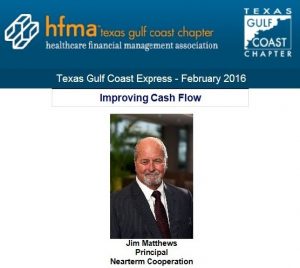Nearterm Blog
Improving Cash Flow
Check out this great article written by our very own Jim Matthews for the HFMA Gulf Coast Express – February 2016 Newsletter: http://files.ctctcdn.com/d6aa2798201/aedf162e-cc2f-46a7-ab9b-c49a1b0708bc.pdf
Improving Cash Flow
Cash flow from patient care revenue is one of the CFO’s main concerns in today’s transitioning industry environment. How can hospitals and healthcare provider organizations develop sustainable and growing cash flow in this new world?
At Nearterm, we believe that the cash flow challenge to hospitals and healthcare facilities today is to build a sound revenue cycle management (RCM) process that balances a quality consumer-patient clinical experience with an improved financial experience. Doing that produces a sustainable and growing cash flow.
How do we get this balance?
It is critical is to get the patient’s financial experience in-line with the patient’s clinical experience, from the front office to the back office. To do this, our customers are integrating new RCM software with the hospital’s clinical and coding systems to mirror and follow patient care cycle, from front to back office.
What should happen in the front office?
Today, given the complexity of healthcare financing, an important component of the front office patient access is financial options counseling. Here, the patient is advised of the anticipated costs and a payment solution such as verification of coverage, insurance or self-pay is determined.
Most patient-access situations will be routine, but others may require a custom solution. The custom cases are the exceptions and they typically need more time and more experienced professionals to handle them.
The better the front office is at what it does, the easier it is for the back office.
What should happen in the back office?
With the new RCM software integrated with the hospital clinical and coding systems, the back office can track the claims process at every point of the clinical experience. This allows the back office to follow the process and address any issues to prevent a claim denial after the patient is discharged. The goal is to have the patient leave with a positive financial experience when discharged.
There will be exceptions such as denials and non-payment. Then the goal becomes account resolution and determining how to prevent such instances in the future.
How does Nearterm help their clients with RCM?
Nearterm is very flexible in how we engage with clients, providing a custom mix of:
- Interim Management
- RCM Consulting
- HIM/Medical Coders (On-site or Remote)
- AR Resolution Specialists (On-site or Remote)
- Healthcare Executive Search
- RCM Project Staffing
- Co-sourcing
Co-sourcing is an interesting new way of looking at how we work with customers.
Clients can co-source the exceptions mentioned previously that occur in the back and front offices. We offer experienced Patient Access and AR Resolutions Specialists as well as HIM/Medical Coders who can work on-site or remotely.
In addition, our RCM interim management professionals can manage RCM process improvements to reduce exceptions and improve patient account resolutions.
We find that the better a client gets at RCM, the more payors will favor them and that in itself can generate more business and more cash flow.
Want to hear more, give us a call at 888-646-1330

